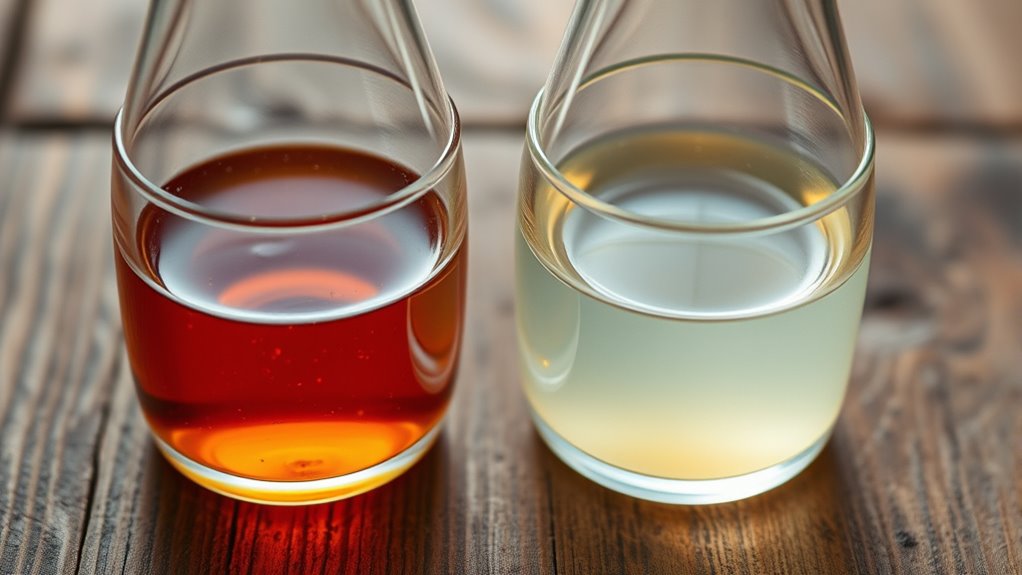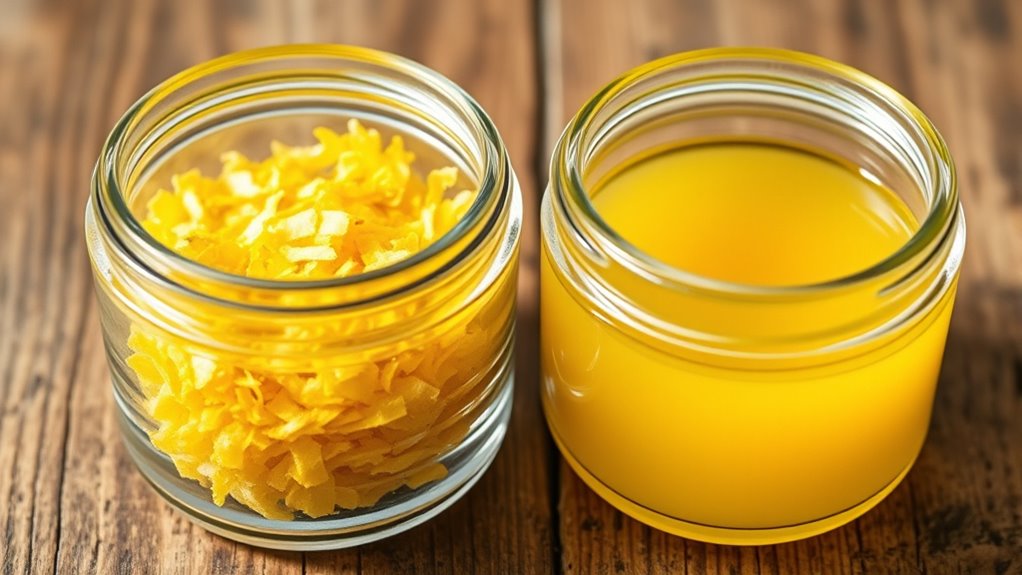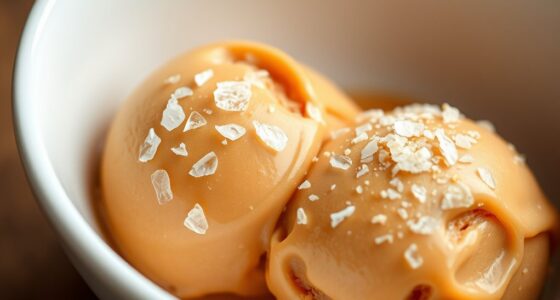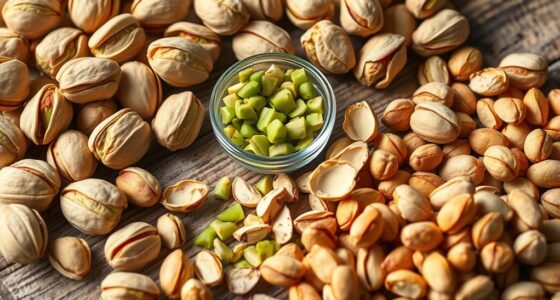To spot the difference between real and imitation flavorings, check the ingredient list on the label. Natural extracts usually list only the original ingredient, like vanilla bean or lemon extract. Imitation flavorings often include a long list of chemicals labeled as “artificial flavor” or “synthetic vanillin.” By learning what to look for, you can make healthier, authentic choices. Stay with us to discover more tips for identifying genuine flavorings.
Key Takeaways
- Check the ingredient list: natural extracts list only the source ingredient, while imitation flavorings list chemicals like artificial flavor or synthetic vanillin.
- Natural extracts usually have simpler labels, mentioning specific sources such as vanilla bean or lemon peel.
- Imitation flavorings contain multiple chemicals and additives, often with unrecognizable or complex chemical names.
- Natural options tend to be more expensive and have a shorter shelf life compared to cheaper, longer-lasting imitation flavors.
- Authentic extracts provide a richer, more complex flavor profile, whereas imitation flavorings offer a more uniform but less nuanced taste.

When it comes to flavorings, understanding the difference between real and imitation options can considerably impact your culinary choices. This awareness helps you select ingredients that best suit your recipe, health considerations, and flavor preferences. Natural extracts are derived directly from fruits, herbs, or spices, often through processes like distillation or cold-pressing. These extracts typically contain only the essence of the original ingredient, offering a pure, authentic taste. For example, pure vanilla extract is made by soaking vanilla beans in alcohol, capturing their true aroma and flavor. When you choose natural extracts, you’re opting for products free from artificial additives, which means fewer preservatives and chemicals in your food. This can lead to a richer, more complex flavor profile that enhances your dishes without overpowering them.
Natural extracts offer pure, authentic flavors by capturing the essence of fruits, herbs, or spices.
In contrast, imitation flavorings rely heavily on artificial additives. These are synthetic compounds designed to mimic the taste and aroma of natural ingredients but are often produced in laboratories. Artificial additives can include chemicals like vanillin, which is a common artificial vanilla flavor. While these flavorings are usually cheaper and have a longer shelf life, they often lack the depth and nuance of natural extracts. Because they are made with artificial additives, they might contain preservatives or other chemical ingredients that you might prefer to avoid. Imitation flavorings are suitable for baking or cooking when you’re looking for a consistent flavor at a lower cost, but they don’t provide the same complexity as natural extracts.
Spotting the difference on product labels is straightforward once you know what to look for. Natural extracts will typically list only the ingredient derived from the original source, such as “vanilla bean extract” or “lemon oil.” Imitation flavorings, on the other hand, often have a long list of chemicals and additives, including terms like “artificial flavor” or “synthetic vanillin.” When reading labels, check for the presence of natural ingredients and avoid products with a laundry list of unrecognizable chemicals. Additionally, some projector technology features like color accuracy and contrast ratio can greatly influence the overall flavor experience of visual content, just as they do with food.
Choosing between natural extracts and imitation flavorings boils down to your priorities—whether you value authenticity, simplicity, and fewer chemical additives, or you’re aiming for affordability and convenience. Knowing how to identify these options empowers you to make better choices in the kitchen, ensuring your dishes taste just as you intend, with ingredients that match your health and flavor goals.
Frequently Asked Questions
Are Natural Flavorings Always Healthier Than Artificial Ones?
You might think natural flavorings are always healthier, but that’s not always true. Natural benefits include fewer synthetic ingredients, which can be better for your health. However, health considerations depend on individual sensitivities and added substances. Always read labels carefully, as natural doesn’t always mean healthier. Balance your choices by understanding both natural benefits and potential additives, making informed decisions to support your health.
How Long Do Flavorings Typically Last on the Shelf?
Like a well-aged wine, flavorings can last quite a while if stored properly. Typically, they stay fresh on the shelf for 1 to 3 years, depending on the type and ingredients. To maximize shelf stability, keep them in a cool, dark place, tightly sealed. Follow storage tips to prevent spoilage; otherwise, your flavorings might lose their punch before their time. Always check for changes in smell or color before use.
Can Imitation Flavorings Cause Allergic Reactions?
Imitation flavorings can cause allergic reactions, especially if you’re sensitive to certain ingredients. Always check ingredient transparency on labels, as some artificial additives may trigger allergies. You might not realize it, but allergy potential varies between products. To stay safe, read labels carefully and consult with a healthcare professional if you have known allergies. Being aware of ingredient transparency helps you avoid reactions from imitation flavorings.
Are There Any Certifications to Verify Flavoring Authenticity?
You wonder if certification standards verify flavoring authenticity. While some products may carry certifications like USDA Organic or Non-GMO Project, these mainly ensure quality and safety, not authenticity. To confirm flavor authenticity, check labels for detailed ingredient info and trusted brands. Keep in mind, authentic flavorings often come with transparency labels, and reputable manufacturers provide authenticity verification through third-party testing or certifications, giving you confidence in what you’re buying.
What Are the Environmental Impacts of Producing Natural vs. Imitation Flavorings?
Imagine you’re in a time machine, and now you’re exploring flavor production’s environmental impacts. Natural flavorings often require sustainable sourcing and have a larger carbon footprint due to farming and extraction. Imitation flavorings usually have a smaller environmental impact since they rely on synthetic processes. By choosing natural, you support sustainability, but consider the trade-offs in environmental costs, while imitation options might be less eco-friendly but more resource-efficient.
Conclusion
Knowing the difference between real and imitation flavorings is like holding a treasure map—you’ll navigate your kitchen with confidence and avoid hidden pitfalls. When you choose real flavorings, you’re revealing a secret garden of authentic taste, while imitation ones are like painted shadows—flashy but lacking depth. Trust your senses and label reading as your guiding stars. With a little practice, you’ll craft dishes bursting with genuine flavor, turning every bite into a true culinary treasure.









